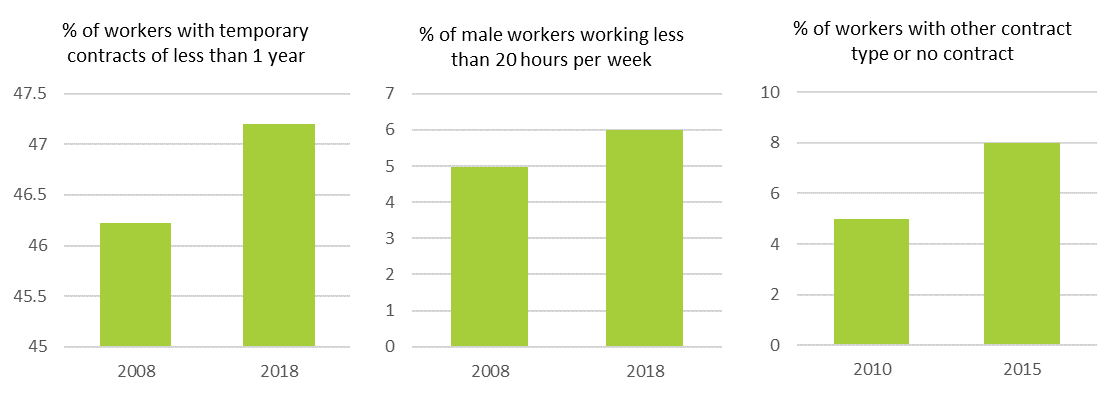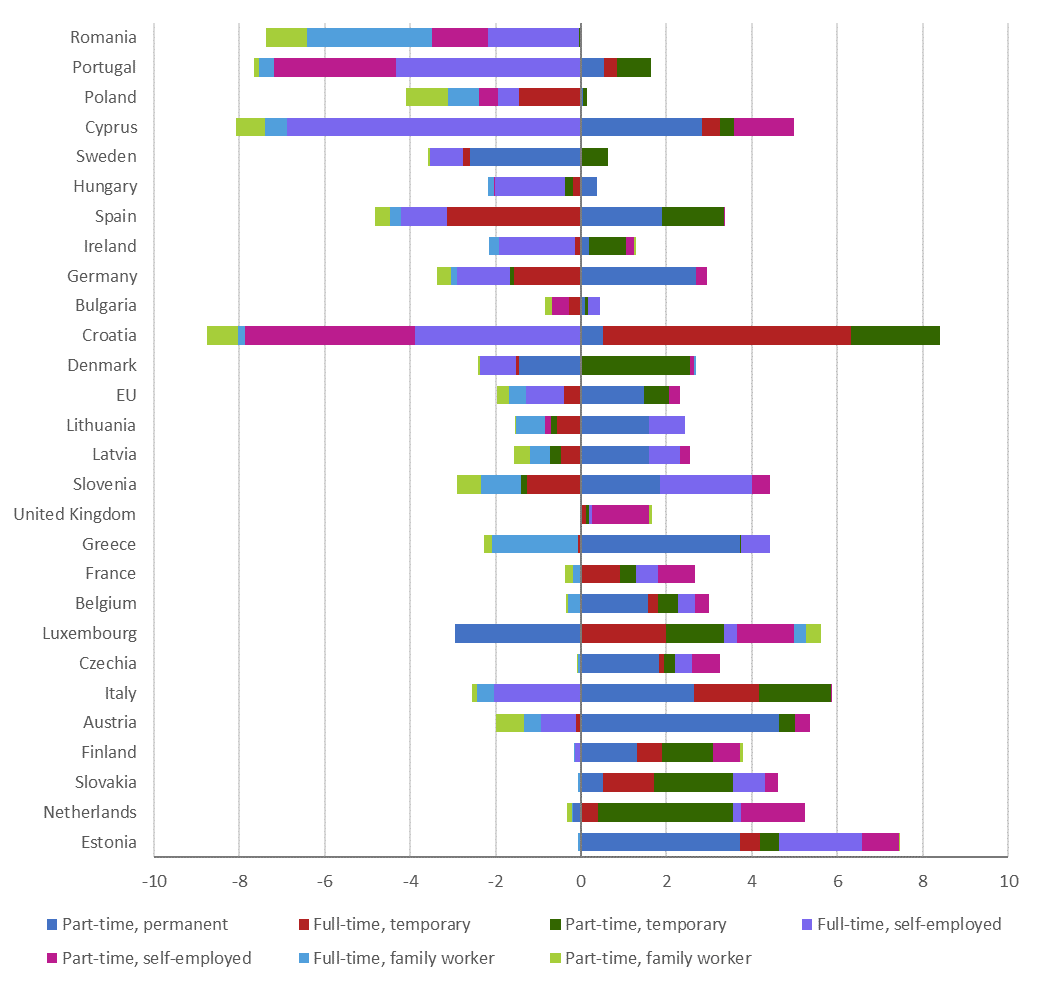Economic downturns expose the vulnerability of a growing number of precarious workers
Up to the start of 2020, recent EU economic and labour market trends were often discussed in terms of the periods before and after the Great Recession. It now appears likely that, in the short- to medium-term, the repercussions of that economic crisis will be dwarfed by the unfolding impact of the COVID-19 pandemic, particularly on businesses and employment in the sectors most affected by the shutdown – not to speak of the cost in human lives.
Up to the start of 2020, recent EU economic and labour market trends were often discussed in terms of the periods before and after the Great Recession. It now appears likely that, in the short- to medium-term, the repercussions of that economic crisis will be dwarfed by the unfolding impact of the COVID-19 pandemic, particularly on businesses and employment in the sectors most affected by the shutdown – not to speak of the cost in human lives. While estimates of this impact largely remain within the realm of speculation at present, the Member States most affected are already reporting a significant spike in new unemployment registrations.
Here I want to outline the impact that economic uncertainty and job loss has on the most precarious workers and, indeed, vulnerable self-employed workers (one-quarter of whom are precarious, according to Eurofound research), and what policy steps have been taken to protect them. This is particularly relevant because the numbers of such workers have increased over the last decade. Precarious work is also a particular feature of some of the sectors most affected by the COVID-19-related shutdowns (such as tourism, hospitality, transport, retail and construction).
This review is based on Eurofound’s just-published flagship report, Labour market change – Trends and policy approaches towards flexibilisation, which covers the years from 2008 to 2018, a period that includes the recession of 2008–2013 and the subsequent return to stability and growth. Although the reasons for that economic downturn differ significantly from those of the COVID-19 crisis, there are still lessons to be drawn.
Rising precariousness in work
Around 6 in 10 European workers have full-time, permanent jobs, which provide a high degree of job security and social protection, although the proportion has fallen slightly since 2008. The rather small reduction disguises a rise in precariousness among many in the remaining group – those who are in non-standard employment. This is demonstrated by the rise in temporary employment among younger workers, the increasing share of short-term temporary contracts, the growing share of men on low-hours part-time contracts, and the rise in the share of workers with some other type of contract or no contract at all, as shown in the charts below.
Figure 1: Rise in different types of non-standard employment, EU27 + UK

Sources: EU-LFS (first and second charts); European Working Conditions Survey (third chart)
There has also been an increase in ‘compound non-standard employment’ in almost all Member States. This is work that combines different non-standard work statuses, such as temporary and part-time or self-employed and part-time. This trend, which has gone hand in hand with the emergence of new business models such as platform work, has contributed to a deepening of labour market divisions between well-protected workers and those with limited access to social protection and employment rights and limited representation by trade unions. In the EU as a whole, the main developments in non-standard employment have been a shift towards permanent part-time employment, temporary part-time employment and part-time self-employment (see Figure 2).
Figure 2: Percentage point change in the composition of non-standard employment, EU27 + UK, 2008–2018

Note: A family worker is family member working in a family business.
Source: EU-LFS
These patterns differ significantly from country to country and pose various policy challenges. One of the most significant is how to give these workers access to social and employment protection. Another is how to enable them to transition from temporary to permanent employment or from part-time to full-time employment if they wish to do so.
The threat of precariousness is even greater for casual workers. A recent Eurofound report demonstrated that the nature of casual work differs from country to country – it can take the form, for instance, of zero-hours contracts, day labour, intermittent work or on-call work. Many casual workers lack a stable and continuous relationship with their employer, placing them at greater risk as the economy contracts. The same is true for the groups of vulnerable self-employed workers referred to above, some of whom can be characterised as bogus self-employed due to their reliance on one (or few) clients, sometimes without the possibility of taking on other customers because their main client has imposed an exclusivity clause.
Publication: Casual work: Characteristics and implications
Gaps in social protection
The flagship report describes how, even during times of economic recovery and relative stability, the consequences of non-standard employment can be significant. Temporary and part-time employees are at greater risk of poverty. Temporary full-time, temporary part-time and self-employed workers are significantly less likely to be covered by sickness and unemployment benefit schemes – an important concern in any economic downturn, including the current COVID-19 crisis. Furthermore, the experience of the Great Recession has shown that temporary workers and those on other precarious contracts tend to be among the first to lose their jobs as the economy contracts – particularly if they are active in the most exposed sectors.
A number of measures have already been taken by the EU and individual Member States to prevent the abuse of casual work and fixed-term contracts and to give employees at least the right to request an improved contract. These are among the goals of the recent EU Directives on Transparent and Predictable Working Conditions and on Work–Life Balance. At national level, some countries have outlawed certain types of casual work or exclusivity clauses. However, many legal uncertainties remain to be addressed. Similarly, the 1999 Fixed-term Work Directive (based on an agreement between the European cross-sectoral social partners) sought to introduce measures to ensure equal treatment and prevent the abusive use of such contracts. However, the Directive provides significant leeway to Member States to achieve this, leading to large variations between them and contributing to different transition rates among employees from fixed-term to permanent employment.
Social protection systems were largely designed with full-time, permanent employees in mind, and while some non-standard employees have access to benefits, this often does not amount to effective protection, as it can be much harder to meet some of the criteria and contribution levels upon which (adequate) benefits are based. It is estimated that around 32% of temporary full-time workers and 39% of temporary part-time workers in the EU do not have access to unemployment benefits. Close to 55% of self-employed workers are also unable to access benefits from such schemes. Furthermore, 38% of self-employed and close to 10% of temporary part-time workers cannot avail of sickness benefits.
Steps to address the gaps
Prior to the COVID-19 crisis, a number of Member States had already moved to implement measures to broaden access to social protection, particularly for self-employed individuals – and to a lesser extent to employees on non-standard contracts. In order to cushion the impact of COVID-19, several (and the UK) have implemented measures to limit the impact on employees through various measures, such as short-time work schemes and, in some cases, temporary bans on redundancies. They have also provided a degree of income protection for (some) self-employed groups. Sickness protection has also been strengthened in a number of countries to broaden access. This opens up the possibility for longer-term amendments to such schemes, expanding contribution criteria to extend coverage.
In many ways, the Coronavirus outbreak, in exposing the weakness of social protection systems, is placing additional pressure on governments to address gaps in them. Thus – as with many other things (such as the boost to remote working) – the COVID-19 crisis may have consequences beyond its immediate impact.
Image @ Dmitry Kalinovsky/Shutterstock
Author
Tina Weber
Senior research managerTina Weber is a senior research manager in Eurofound’s Working Life unit. Her work has focused on labour shortages, the impact of hybrid work and an ‘always on’ culture and the right to disconnect, working conditions and social protection measures for self-employed workers and the impact of the twin transitions on employment, working conditions and industrial relations. She is responsible for studies assessing the representativeness of European social partner organisations. She has also carried out research on European Works Councils and the evolution of industrial relations and social dialogue in the European Union. Prior to joining Eurofound in 2019, she worked for a private research institute primarily carrying out impact assessments and evaluations of EU labour law and labour market policies. Tina holds a PhD in Political Sciences from the University of Edinburgh which focussed on the role of national trade unions and employers’ organisations in the European social dialogue.
Related content
16 April 2020
Labour market change: Trends and policy approaches towards flexibilisation
What have been the major trends and policy developments regarding the flexibilisation of employment in recent years? Eurofound’s work programme for 2017–2020 set out to document and capture these changes in the world of work. This flagship publication provides an overview of developments in Europe in the wake of the global financial crisis, as well as mapping the ongoing challenges and policy approaches taken at EU and national levels to find the right balance between flexibility and security in the labour market. Based, in part, on European Working Conditions Survey data, the findings of this report map labour market changes between 2008 and 2018 with a specific focus on working time, contract type and employment status.
20 December 2019
Casual work: Characteristics and implications
Casual work, both intermittent and on-call, contributes to labour market flexibility and is therefore increasingly used across Europe. In some countries, practices go beyond the use of casual employment contracts to include other types of contracts and forms of self-employment. While it offers some advantages for both employers and workers, it is often discussed by policymakers at EU and national levels due to the observed negative consequences it has for some workers. Impacts include economic insecurity and unpredictability of working time, which in turn affect workers’ health, well-being and social security. From a labour market perspective, casual work raises concerns about decent social inclusion of vulnerable groups, labour market segmentation and more general trends towards fragmentation of work and brain drain. Some policy responses have already been implemented to tackle these issues; further policy pointers are flagged in the report.
21 September 2017
Exploring self-employment in the European Union
In the rapidly changing world of work, the traditional dichotomy of employee and self-employed is insufficient to capture the wide diversity of self-employed workers in Europe today. This report identifies five categories of self-employed, reflecting the wide-ranging attitudes, income levels, and health and well-being among this diverse group. Based on data from the sixth European Working Conditions Survey (EWCS) and the European Union Labour Force Survey (EU-LFS), the analysis reveals that the majority of self-employed workers enjoy high levels of job quality. However, there are concerns in relation to so-called ‘economically dependent workers’: while they are classed as self-employed, they lack both the autonomy that self-employment usually offers and the social protection granted by regular employment. Some policy approaches of Member States to this ‘in-between’ employment status are described in detail, which are of relevance for the discussions around the European Pillar of Social Rights.